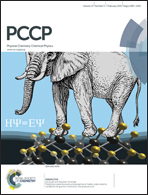A direct Fe–O coordination at the FePc/MoOx interface investigated by XPS and NEXAFS spectroscopies†
Abstract
Molecule–substrate interaction plays a vital role in determining the electronic structures and charge transfer properties in organic-transition metal oxides (TMOs) hybridized devices. In this work, the interactions at the FePc/MoO3 interface has been investigated in detail by using synchrotron radiation photoemission spectroscopy (SRPES) and near-edge X-ray absorption fine structure (NEXAFS) spectroscopy. Compared with the annealing of the bare MoO3 film, the FePc adsorption is found to promote the thermal reduction of the underlying MoO3 film. XPS and NEXAFS experimental results unanimously demonstrate a strong electronic coupling between FePc molecules and the MoOx (x < 3) substrate. A direct Fe–O coordination at the interface as well as an electron transfer from the molecules toward the substrate is proposed. This strong coupling is compatible with a facile electron transfer from FePc molecules toward electrode through a MoOx interlayer. The understanding of the molecule–substrate interaction at the atomic level is of significance in engineering functionalized surfaces with potential applications in nanoscience, molecular electronics and photonics.


 Please wait while we load your content...
Please wait while we load your content...